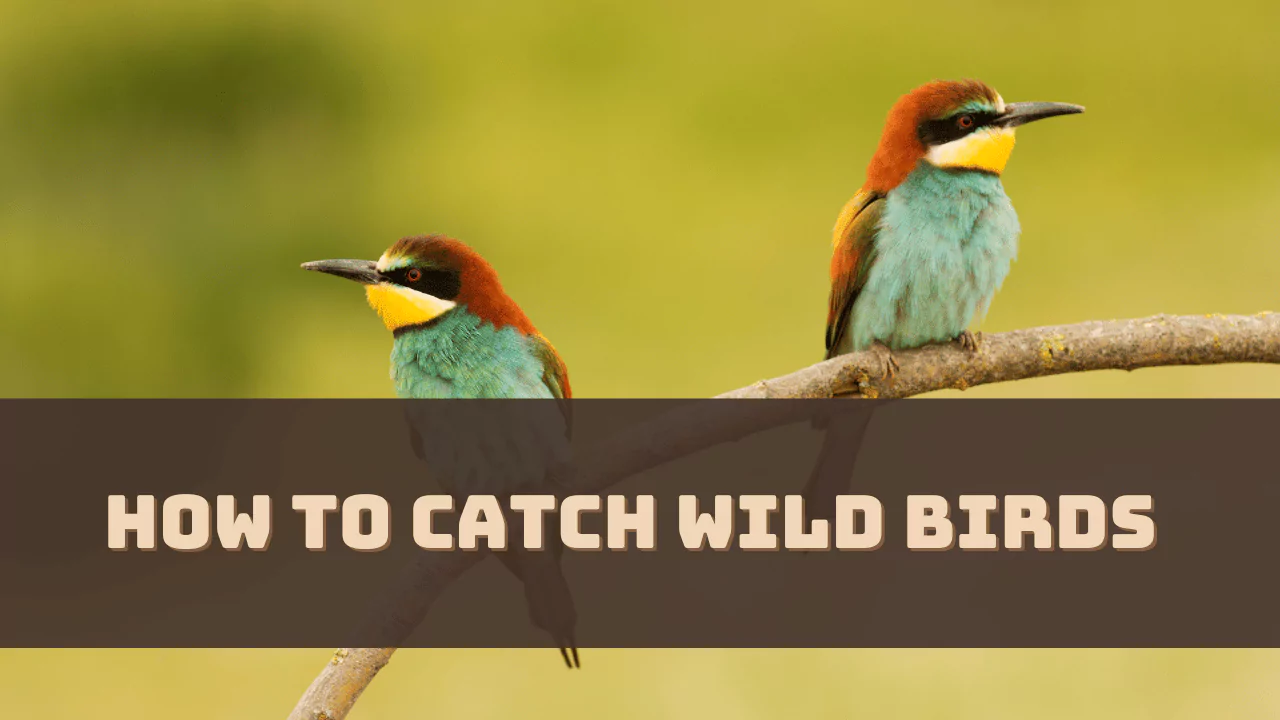You might have seen wild birds venturing into your backyard and they play an essential role in the local ecosystem by protecting your garden against the pest. But, in case you think they have become a nuisance, then you need to handle the wild bird population and for this, the easiest way out is to catch them. You can use bait or set up a trap to handle the bird carefully.
However, you must always abide by your state about trapping birds. In some countries, it is illegal and you might have to go through high compensation or even jail. So, always check with your local law before you take any step. There are also certain birds, which are labeled as endangered and trapping them or hurting them is strictly prohibited
Alternatively, you might also want to catch a wild bird to pet it or to help a bird which has undergone any kind of injury. So, whatever your reason, here are a few simple steps that can help you to trap the bird.
Case 1: If the Wild Bird is Injured
If the wild bird is injured and you find it lying in your backyard, then here are the methods you can use to capture it and provide appropriate treatment.
Ensure that the Bird is Injured
In most cases, it has been found that the bird does not need any assistance, but people forcefully come to help which can worsen the situation. So, if you find that a bird has smacked into your window, then wait for a few minutes and check whether the bird is dizzy and able to get back to its normal condition. If not, then its wings might have been injured; so look for bent wings at an odd angle. It can be an indication of strain or broken bone.
Look out for Parents
If the bird is young, then you need to wait for its parents to arrive, because most of the time it is the parents teaching them how to fly and as these babies do not have all the feathers yet, they end up falling on the ground. So, if their parents are nearby, they might come to the rescue. Meanwhile, you have to keep an eye on the baby, so that no predators come around.
Use Gloves
Wild birds can be infected by many different kinds of diseases which are easily passed on to humans. So, before you pick up the bird with your bare hand, always put on thick and sturdy gloves. This will prevent you from coming in direct skin contact with the bird. Also, there are chances that the bird can panic, feel threatened, and peck you, then these gloves will protect you. When you are done, wash the gloves to prevent contamination of pests to other pets or birds in your house.
Use of a Piece of Fabric
When you are trying to catch a wild bird, never scare it and always try to wrap it up in something. You can use a piece of fabric, approach from the behind, don’t let it see you and pick it up. You have to use one hand for smaller birds and if the bird is a full-grown adult then use both your hands. Never apply pressure on the neck rather use your fingers gently around the body leaving room for the head to poke through your fingers. Also, be careful while you are holding the feet as they can break easily.
Find a Safe Place
If you find that the bird is getting startled, when you pick it up, don’t chase it or try to grab it roughly, rather wait for it to calm down and then try again. If the bird gets panicked, then it can hurt itself more. After you have caught it, use a cardboard box, create a soft bedding and put the bird in the box. Make small holes and keep the box closed, as darkness would help to reduce the anxiety.
Call a Wildlife Rehabilitator
There are trained professionals who can help you in rescuing the bird and rehabilitating it. Wild birds are quite different from pet birds, so it is better to leave the situation to an expert. Call them to describe the situation and they can guide you on how to help the bird until the aid arrives. The wildlife rehabilitated can also help you provide valuable information on feeding, nesting and keeping the bird safe and healthy until it learns to fly again. If the injury is quite serious, you might be advised to bring the bird to the vet.
Take the Bird to the Vet
If you are unable to get in touch with a wildlife rehabilitator in your area, then you need to give proper medical attention to it for which you can take it to a veterinarian. Meanwhile, provide the bird with some seeds and water. If the injury is light, then the bird will be able to fly out within a couple of hours, but if it is serious then you need to find help.
Case 2: Trapping a Healthy Wild Bird
When you are trying to catch your healthy wild bird, then you need to observe the bird’s behavior. This would help to increase the chances of success. You have to know the type of bird and its habits and preferences. Some birds prefer seeds or fruits, while others prefer insects. So, if you want to lure the bird towards the trap you have to understand their preferences and determine the best time of the day when you can catch them; as some are active in the morning while others are in the evening. You have to keep patience and learn the skills of catching wild birds.
Tools Required
To catch the wild bird, you need certain tools, such as the right bird feeder, so that the bird visits your garden every day. It should be placed in an ideal location to attract the right birds and always set up the trap using non-toxic baits. You also need to be careful about choosing the bait, otherwise you might accidentally trap an animal.
Provide the Birds with Food
If you want to attract the birds, you have to provide them with the food that they enjoy, such as sunflower seeds or suet cakes. Also, keep the bird feeder well-maintained and clean to prevent contamination or bacterial growth. Do not use any kind of pesticides or chemicals near the feeder, or on the plants of your backyard, otherwise the bird might get deterred.
Understand the Feeding Pattern of Bird
You have to follow the daily routine of the birds and observe their feeding pattern. Identify whether they are attracted to any specific food or when they are eating a lot. You have to wait for the perfect moment to strike. So, create an environment which is inviting, by adding water, and food and giving access to nesting areas.
Placement of the Trap
After you are done building the trap or purchasing it, set it; place that trap in your backyard, into an open area, where there are no other perches. Try not to use seeds at first as squirrels get attracted to these. So, keep it simple and efficient, wait for the birds to get trapped. Based on the weight of the bird you might have to change the bird trap.
Catch the Bird
If you want to catch the bird from the trap, you have to walk slowly towards it, so that the bird does not fly away sensing danger. Always avoid eye contact with the bird; otherwise, there are chances for it to escape. Also, to minimize injury to the bird, cover the trap with a towel or blanket.
What are the Different Kinds of Traps that You Can Build?
The different kinds of traps that you can use to capture a wild bird are – the bucket and cage method which is an old-fashioned technique or the cardboard track technique which is quite effective and needs little preparation.
Different Types of Bird Traps in the Market
You can find three types of bird traps:
- Ground Trap – which is placed on the ground and covered with bait and as soon as a bird enters, the trap gets triggered and the door closes.
- Funnel Trap – which is a one-way entrance where the bird is guided inside but is unable to escape. This trap is generally used when one is trying to catch multiple birds at the same time
- Net Trap – where the net is suspended between two poles which prove to be effective for catching small birds who are flying. This should be certified by professionals before use, to ensure the safety of the bird.
What are the Effective Baits for Different Birds?
If you want to trap different kinds of bird species then you have to get the right bait to attract them.
- For small birds, you can use suet cake and sunflower seeds.
- For migratory birds use a sugar water solution.
- For predatory birds, you have to use meat-based bait, such as chicken or beef.
What to Consider While Selecting the Trap Placement Location?
When you are selecting a location to place the trap and catch wild birds, you have to consider the level of pest infestation in the area, environmental exposure, temperature level and whether it is a traffic zone. Also, consider the path of airflow and the presence of children or pets around it.
Why is the Trap Unable to Get Birds?
Due to incorrect trap placement or inadequate baiting techniques, the trap might fail to catch birds. Also, the trap size, predator interference and social ability of the birds are the potential reasons behind bird trap failure.
When is the Best Time to Catch a Wild Bird?
The best time to catch a wild bird is early morning or late afternoon; when they are active and also forging for food.
What You Should Not Do with a Wild Bird after Catching It?
After you have caught a wild bird, always keep it in a safe and quiet place and notice whether it can be tamed. Otherwise, you have to release it in the same area where it was caught as in a different area it is unlikely to survive.
What Precautions Should be Maintained while Handling Birds?
When you are handling birds, you must wash your hands frequently, cover your mouth and nose, and always use an alcohol-based sanitiser. You must not touch your eyes after holding the bird and always maintain a social distance before you clean up to avoid contamination or spreading of infection from the infected bird.




